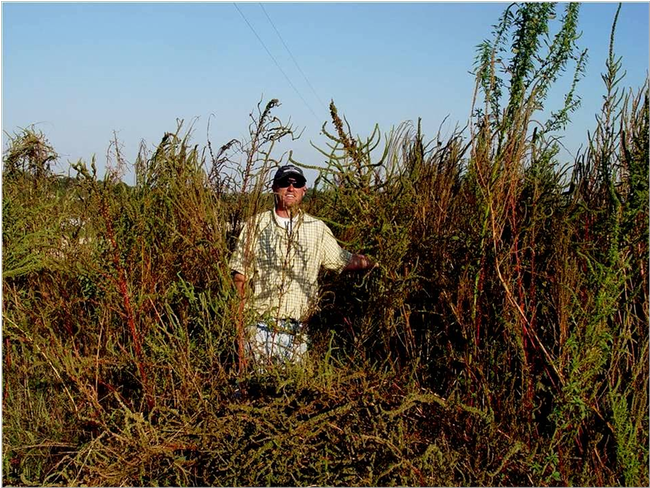Glyphosate-resistant (GR) Palmer amaranth is, currently, the most significant weedy pest of cotton grown in the SE US. In order to reduce population size, maximize herbicide efficacy and prevent the development of further resistances, cotton growers must consider using additional mechanical (i.e. tillage) and cultural (i.e. cover crops) weed management strategies. Small plot experiments conducted in Georgia between 2008 and 2010 showed that the use of deep-tillage plus a heavy rye cover crop, when paired with a herbicide program consisting of both residual and POST-applied herbicides, significantly reduced Palmer amaranth densities and increased cotton yields. The objective of this study was to evaluate the use of heavy-residue cover crops and a single soil inversion event for control GR Palmer amaranth in large-scale, grower-managed, on-farm trials.
Figure 1. Georgia County extension personnel in a cotton field infested with GR Palmer amaranth.
Methods:
Three fields managed by grower-cooperators were selected for use in a study to evaluate the effectiveness of deep tillage and a rye cover crop for managing severe GR Palmer amaranth in cotton. Demonstration sites were located in Worth, Seminole and Screven Counties, in Georgia. All fields were approximately 4 Ha (10 A) in size and were planted to cotton the previous year (2010). Grower-cooperators and county extension agents described the local GR Palmer amaranth infestations as being moderate to severe. Three treatments, which included
1) cotton strip-tilled into winter weed residue [bare ground],
2) cotton strip-tilled into a rolled rye cover crop [no deep-tillage + rye], and
3) cotton strip-tilled into a rolled rye cover crop planted on deep-tilled soil [deep-tillage + rye]
were established at each site during the 2010-2011 planting season. Each treatment plot encompassed an area > 1 Ha in size. Deep-tillage (to a depth of 32 cm or 13 inches) using moldboard plows occurred in autumn/winter of 2010, prior to planting rye. Winter rye was planted at 90-120 kg/Ha (1.5-2 bu/A) in order to maximize biomass production (>4000 kg/Ha or 3500 lbs/A). Rye cover crops were terminated and rolled at least 2 weeks prior to cotton planting.
Figure 2. Location of on-farm field trials in 2010-2011.
Cotton was planted at all locations by June 1, 2011. Growers employed chemical weed control programs that included the use of pre-plant/PRE, POST and PD (layby) herbicides as advised by their local county extension agents. Within site, herbicides were kept constant across the three tillage/cover crop treatments (i.e. each plot at each site received received the same herbicides, regardless of tillage or cover crop). Weed densities for each site were obtained by counting all of the weeds present in 25% of the crop production rows assigned to each treatment, and then converting the numbers to plants/Ha. Weed counts were made throughout the cotton production season.
Results:
In this current trial, Palmer amaranth density in cotton was affected by the tillage and cover crop treatments, across all three sites. Weed densities were greatest in the plots where herbicides (bare ground) and herbicides plus a rye cover crop (no deep-tillage + rye) were the only method(s) of weed control. Palmer amaranth densities were substantially lower in plots where a pre-plant soil inversion operation, a rye cover crop and herbicides (deep-tillage + rye) were used, collectively, for weed management.
When averaged over all three sites, mean Palmer amaranth densities following preplant/PRE herbicide applications in the bare ground, no deep-tillage + rye, and deep-tillage + rye treatments were 990, 470, and 10 plants/Ha, respectively.
When averaged over sites, mean Palmer amaranth densities following POST herbicide applications in the bare ground, no deep-tillage + rye, and deep-tillage + rye treatments were 1340, 1040, and 80 plants/Ha, respectively.
When averaged across sites, mean Palmer amaranth densities following layby/POST herbicide applications were numerically greatest in the no deep-tillage + rye (480 plants/Ha) treatment, followed by the bare ground (430 plants/Ha) and deep-tillage + rye (30 plants/Ha) plots
Figure 3. Mean Palmer amaranth densities (plants/ha) averaged across all three experimental sites following PRE, POST, and layby (i.e. PD) or POST herbicide applications in response to tillage and cover crop treatments.
Summary:
In 2010-2011, three on-farm field trials (Seminole, Screven, and Worth Counties in Georgia) were established with the assistance of farmer-cooperators and County extension agents to evaluate the effectiveness of an integrated weed management program incorporating heavy rye residues, deep-tillage, and recommended herbicide programs for controlling GR Palmer amaranth in cotton under ‘real world’ conditions. Results from these large-scale, on-farm trials in Georgia showed that the combined program significantly reduced GR Palmer amaranth densities relative to the rye plus herbicide and herbicide-only treatments at every observation period (following PRE, POST, and layby applications).
Results from this study concur with other, large-scale experiments (also conducted by the University of Georgia). In two on-farm, dry-land cotton studies conducted in 2012, the addition of a heavy rye cover crop reduced Palmer amaranth populations at harvest 70 to 95% and increased yields 16 to 23%, when all other variables, including herbicide program, were held constant. Although numerous benefits from this type of integrated system exist, there are challenges that must be addressed, including: finding time to get the rye cover established, handling increased nitrogen requirements, purchasing or building a roller, and obtaining a uniform cotton stand. Because Palmer amaranth seed may persist in the soil for up to three years, deep tillage operations should not be carried out too frequently in order to prevent the return of buried seed to the soil surface (//ucanr.edu/blogs/blogcore/postdetail.cfm?postnum=10297).


